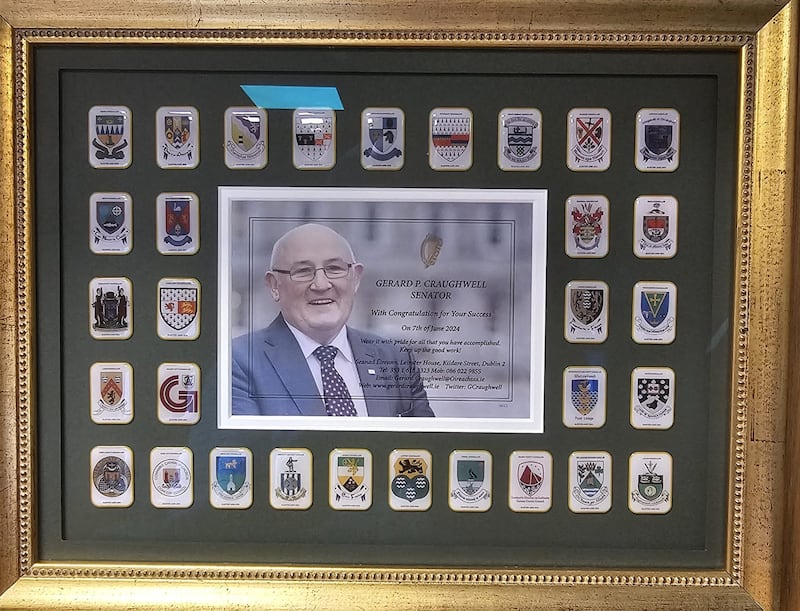Evidence pointing to a late November election continues to pile up, despite the Taoiseach and the Tánaiste’s increasingly wan insistence that it will be happening next year.
If the fervent wishes of all those in Leinster House were enough to influence a decision, it would be called tomorrow.
RTÉ’s Fiachra Ó Cionnaith’s tweeted a telltale photo this week of pallets of Fianna Fáil election posters shrink-wrapped with hundreds of smiling Micheál Martins and a slogan on the front plaintively whispering “Moving Forward Together” and “With Whoever Will Have Us” on the reverse.
And as the parties attempt to stuff as much money into the coffers as possible before the election is called, Fine Gael supporters are noting with interest that the date of its Superdraw money-raising lottery has been brought forward from December 5th.
READ MORE
There is major deck-clearing going on in Government Buildings.
Sinn Féin is currently banjaxed. Jennifer Bray reports elsewhere on its latest catastrophe where they’re tearing the party to shreds in Kildare.
Oh, and here’s what some see as the clincher. The Late Late Toy Show airs this year on December 6th, with “insiders” swearing that programme planners in Montrose moved it back from its traditional slot at the end of November to avoid a possible clash with general election coverage.
And all those Fine Gael posters and billboards appearing like a rash on gable walls and bus shelters throughout the land.
Like the billboard promising “A new energy for Kildare South” with candidates Joe Neville, Evie Sammon and Bernard Durkan alongside high-wattage Simon Harris beaming down on the masses. FG’s runners in Kildare South must have been shocked to see it. The aforementioned candidates are actually standing in Kildare North.

The sense of indecent haste continues with Cllr John Paul O’Shea, the party’s candidate in Cork North West, ending up on the side of a bus shelter in Listowel, birthplace of Billy O’Shea, Fine Gael’s actual candidate in Kerry.

And hats off to Minister for Higher Education Patrick O’Donovan, spectacularly ignoring his Government’s line that the election will be next year with huge billboards in Limerick.
Featuring one huge photo of Patrick’s smiley phizog, it bears a simple message, writ large: “Patrick O’Donovan TD. Your Cabinet Minister for Limerick.”
Nah. It’ll be in February.

Senator pins his hopes on re-election
With TDs and senators all of a dither this week over claims that one of their own is a Russian secret agent, we were surprised not to hear the stentorian tones of former soldier Senator Gerard Craughwell holding forth on this critical issue of national security.
Members of the Upper House have seemed far more exercised on this matter than their Dáil counterparts.
Rear-Admiral Craughwell, who recently put the wind up Putin by threatening to send out a flotilla of finger-wagging Irish parliamentarians to monitor Russian naval manoeuvres in Irish waters, takes a keen interest in defence matters and his observations on the unfolding espionage crisis were much anticipated.
Gerard, however, has been deeply involved in manoeuvres of a different kind. He is busy ensuring his re-election to the Seanad.
A member of the Seanad’s independent group of senators, he was first elected in 2014, unexpectedly winning a by-election on the Cultural and Education panel after Fine Gael’s shoo-in candidate became embroiled in a row over government stroke politics and withdrew from the race.
Despite it being incredibly tough for an independent to win in a contest where elected local politicians control the vote, he has managed to keep his seat by keeping the councillors sweet.
This year, he splashed out on over 940 lapel badges and posted one to every councillor in the country. The pins, produced by Abbey Badges in Blackrock, are attractive items and have been “well received” says Senator Craughwell.
“You will note the pins are unique with the name of the council on top, the council coat of arms and ‘elected June 2024′ at the bottom,” he tells us. “They are a mark of recognition and a collector’s item.”
Each pin comes with a card from Gerard congratulating them on their success. “Wear it with pride for all that you have accomplished. Keep up the good work!”
He also encloses full details of his particulars in case anyone wants to take them down.
The race for the next Seanad may not have officially started, but it’s already in full swing.
“Be sure I will run!” parps the bullish Craughwell.
A slippery situation
Of the many tributes paid to Mary O’Rourke since her death just over a week ago, one of the more interesting ones came from Ivan Yates, who was Fine Gael spokesman on public enterprise when Mary ran the department.
Speaking on his weekly podcast with Matt Cooper, Ivan was full of praise for the political acumen of his erstwhile sparring partner – but he didn’t rate her at all as a minister.
He was very firmly on the side of Brian Joyce, the former chairman of CIÉ who resigned on her ministerial watch citing “interference”, among other things.
After the bombshell broke, Mary was shocked, breathlessly telling Morning Ireland how she heard the news.
Ivan spoke vaguely of the way “this pressure came up”, which led to Mary revealing to the nation that she was “in the bath listening to the totally unannounced, unexpected resignation of Mr Joyce”.
He regaled himself with details of his heroic part in this affair – how he played a blinder on the same programme a short time later, noting that after she went on about her bath “she proceeded to completely drop the towel and put the knife into Mr Joyce in a quite outrageous way”.
Then they clashed on Prime Time, where she continued “savaging” Joyce while “letting on she didn’t know anything about it [the resignation] but she absolutely garrotted him”.
Mary O’Rourke may not be around now to contradict him, but Richard Moore, her media adviser at the time, offers a more detailed timeline of what happened all those ago. It’s a tale full of drama and intrigue and he has never spoken about it before.
That memorable bath and resignation episode happened on a Tuesday morning in the year 2000. On the previous day, Monday, March 6th, Mary was due to appear on RTÉ's Questions and Answers.
There would, doubtless, be a question on the ongoing rows between her and her CIÉ chairman over how the organisation and, in particular, the rail system was funded and run. Joyce was appointed by Fine Gael in 1995 and had been due to retire in November 2000. Relations between them were always poor and Mary had been demanding a meeting with CIÉ’s chief executive later that week to discuss the company’s performance.
Sadly, in a heartbreaking turn of events, the programme was cancelled due to the unexpected death of the presenter’s son.
On Tuesday morning, The Irish Times splashed with a front page exclusive by Arthur Beesley. The story, with its leaked details, was filed on Monday night.
Brian Joyce had resigned because of Mary O’Rourke’s “interference”.
This came as a bolt from the blue to the Department. The usual practice if the chair of a semi-state was going to resign (or write a stern rebuke) was to call the Minister’s office first to let them know to expect a very important letter.
That never happened in this case, recalls Richard Moore.
Instead, Joyce’s resignation letter was hand-delivered to the minister’s office in Kildare Street after 8pm on Monday evening when she would have been in RTÉ, had circumstances not intervened. It was accepted by the security/service officer on duty and the unknown individual who delivered it said nothing about alerting the Minister or the Department to its importance.
It was eventually opened on Tuesday, well after its contents had been revealed by The Irish Times. And well after RTÉ led its 7am radio bulletin with a report based on Beesley’s scoop.
When she heard it, a stunned Mary immediately rang her media adviser. He headed straight into the office, getting in at 7.30am to find her already at her desk. She spoke to Morning Ireland after the 8am bulletin, famously declaring where she was when she heard the shock news.
Afterwards, some commentators described the sharing of this detail as a masterstroke. All anyone could remember was that she was in the bath when somebody resigned and the story quickly faded.
But back to RTÉ, where the plot thickens.
Had Q&A not been cancelled at the last minute, Mary would have been on the panel with Fine Gael’s Jim Mitchell. A view quickly formed in Fianna Fáil circles – one shared by Moore – that the Minister escaped an ambush that night.
Inevitably, she would have been asked about her troubled relationship with CIÉ and answered it with her usual confidence, only for someone – possibly the late Mr Mitchell – to remark if she was such a great minister, how come her chairman had resigned?
Cue bafflement, consternation ... carnage.
There is a delicious final twist.
Much later on that fateful Tuesday, the then minister of state Mary Hanafin contacted O’Rourke about a strange voice message someone had left on her mobile phone.
Richard Moore says it went something like: “Hello Ivan, I think matters have worked out well; let me know what else I can do.”
In those days, TDs were allocated phones with sequenced numbers. There was (and still is) a one-digit difference between the phone numbers of Ivan Yates and Mary Hanafin. Back then, she was used to people leaving messages placing bets on horses.
Yates was a bookie as well as an ambitious politician.
O’Rourke believed she had her “gotcha!” moment.
Her team downloaded Hanafin’s recording on to cassette tapes with a view to releasing it to the media at a snap press conference. It would have been sensational, particularly as the man who thought he was ringing Ivan Yates (and who did not get on with O’Rourke) gave his first name.
But in the end they decided against it.
Moore, who went on to set up a successful communications consultancy, felt this would complicate the unfolding resignation commentary – which was going well for his minister, while it might be best not to remind people of Fianna Fáil’s past history with recording phone calls.
It took a lot of persuading, but Mary agreed to say nothing.
A hard ask for the woman concerned, but she kept her part of the bargain.
- Listen to our Inside Politics podcast for the best political chat and analysis
- Sign up for push alerts and have the best news, analysis and comment delivered directly to your phone
- Find The Irish Times on WhatsApp and stay up to date















